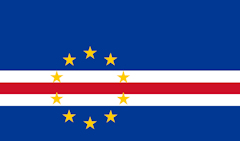 Picking up steam, I can feel it… It looks like we have a run of African countries going on here (though, if I hadn’t done Canada out of order, we’d be there right now) with Cameroon, Cape Verde, Central African Republic, and Chad. I’ll try to keep the posts as varied as the cuisines!
Picking up steam, I can feel it… It looks like we have a run of African countries going on here (though, if I hadn’t done Canada out of order, we’d be there right now) with Cameroon, Cape Verde, Central African Republic, and Chad. I’ll try to keep the posts as varied as the cuisines!
So, our 35th entry in The Bread & Soup Project, Cape Verde, or, officially, Republic of Cabo Verde, is a group, an archipelago, of ten inhabited islands (and, on the map, 4 very small ones that I presume aren’t) in the Atlantic, located roughly 400 miles off the coast of Senegal and Mauritania, northwest Africa. The land mass rolls in at 4,033 square kilometers, or 1,557 square miles, or, roughly, the size of Rhode Island, which is… not an island (that’s a story you might want to look up).
When the Portuguese discovered the islands in 1456 they were uninhabited, and became the first tropical European colony. There’s some evidence of ancient visits by the Phoenicians, Moors, and various African groups prior, but none had stayed and established habitation. They were ideally situated as a stopping point enroute to “the new world”, and quickly became not only a waypoint for commercial shipping, but also for the burgeoning slave trade from western Africa. In 1951 the islands became an overseas protectorate rather than a colony, and in 1975 achieved full independence, but obviously, there’s both a strong Portuguese and west African heritage. There was also an influx during the Inquisition of Portuguese, Spanish, and Italian Jews and Muslims.
The population is around 550,000, fewer than the US’ least populated state, Wyoming (570,000), but roughly equal to the metropolitan population of Tucson, Arizona. The capital city is Praia, the two major languages are Portuguese and a local Cape Verdean Creole. Not surprisingly given the heritage, the population is a little over three-quarters Roman Catholic.
Let’s jump to the world of food, with strong influences from both of its major heritage lines, which factored into my choice of dishes. I wanted one each that was relatively representative of both lines of cuisine. For our bread, or filled bread, it was an easy choice, the renowned Pasteles com o Diablo Dentro – pastries with the devil inside. For the soup, I debated among several, and at first leaned heavily towards Cachupa, a rich bean based soup that has two versions – the “rica” or rich version with a mix of meats and sausages, akin to feijoada in Brazil; and the “pobre” or poor version, much simpler, and with bits of locally caught fish. In the end, I decided on another island favorite, with strong ties back to Portugal, and the Cape Verdean version of Caldo Verde, green broth.
I have to admit, looking at the ingredients for my pastel dough, I had some concerns. I mean, there’s literally nothing there but a sweet potato and some cornmeal. No salt, no binder, like an egg…. But, I’m game to give it a shot. I have to admit, I may have cheated slightly, I peeled and diced the sweet potato, and then boiled it in salted water, which none of the recipes I found specified. Maybe it’s a given, maybe I’ve just gone and added a slight amount of salt to a dough that isn’t supposed to have it.
I used my potato ricer again on the boiled sweet potatoes, and mixed them into the cornmeal. You need a small amount of water – I probably ended up, for this small quantity, using 2 tablespoons (I was making this for two), just enough to get a relatively smooth dough with a texture like soft clay.
Set the dough aside, wrapped so it doesn’t dry out, and make the filling. We’ve got a piece of fresh tuna, some tomato, onion, garlic, chili, lemon, and tomato paste. Salt and pepper a given. Again, making a small quantity – figuring on roughly four pasteles instead of the dozen or more that most recipes out there aim for.
Chop up the onion, tomato, garlic, and chili, and dice the tuna. Sauté all but the tomato in a drizzle of oil, with a pinch of salt and pepper, until the onion is soft. Add a dollop of tomato paste – I used maybe a teaspoon of it for this quantity – and cook another minute. Add the tomato and cook until soft. Then add the diced tuna and cook for about two minutes. You don’t want to completely cook it through, because the filling is going to get cooked more when you’re cooking the pasteles at the end, and you don’t want overcooked, dry tuna. This can also be made with canned tuna, but then, you will have a more dried out fish. Taste, adjust seasoning if needed.
I’m guessing there’s a trick to working with this dough. It really doesn’t hold together well when you roll it out or, more especially, fold it over. It occurred to me after the fact that maybe I should have rolled them out on something like waxed paper or plastic wrap, allowing me to fold them over more easily. I’ve done that in the past with some trickier doughs and not sure why it didn’t occur to me to do it this time.
Divide the filing, fold them over, seal them all up, do your best to seal the cracks that appear…
… and fry them up in hot oil until golden brown on both sides. Drain on a paper towel to get rid of excess oil, and we’re ready for dinner.
Of course, we’ve got to have our soup made. This one’s pretty quick and easy. We’ve got chopped onion, sliced garlic, sliced cured chorizo, diced potato, and torn kale. In retrospect, tradition or not, I’d probably shred it and make it finer – these were pieces that were all around 1-1½” diameter. There’s also a pot of chicken stock heating up over on the stove.
Skipping over visuals for each step. First, cook the chorizo slices in a splash of oil until they’re lightly browned on both sides. Remove them from the pot and set them aside. Add the onions and cook for about five minutes. Add the garlic slices and cook for about two minutes. Salt and pepper used as we go, but be careful on the salt, depending on how much your chicken stock has. Add the potatoes and chicken stock and bring to a boil. Cook for about fifteen minutes until the potatoes are nice and soft.
Now, we get to what is apparently a matter of contention. Consistency. Some people just jump on to adding the kale, some people puree the whole thing, and if they do, it’s a question of whether to make it smooth or leave it chunky. And, does the chorizo get pureed into it or left whole? So I went an in-between route, and ladled out about half of the soup and pureed that along with most of the chorizo. I decided to go with what sounded like a lovely tradition of putting “one coin” of chorizo in each bowl at the end, so I kept aside 4 pieces of chorizo (since I guessed this would be about four bowls of soup), and put the rest in the blender.
Pour the blended mixture back into the pot, and now we’ve got a creamy consistency but still a good amount of chunks of potato, bits of onion and chorizo, and sliced garlic.
Bring back to a boil, add the kale, and… well, the recommendations were all for only cooking it five minutes at that point. And that was okay, but we found the kale still a little chewy. I kept it on a low simmer for another ten minutes until the kale was nice and soft. Add salt and pepper if needed (I didn’t think so, my chicken stock had enough).
And, serve! Pasteles com o Diablo Dentro and Caldo Verde. Note the single chorizo “coin” in the bowl. Just a nice visual touch, I imagine it has some sort of superstition attached to it. I’d happily make and eat either of these again. The pasteles need some work, just on technique, it may be I’m doing something slightly wrong, or it may just take practice – I remember similar problems with basic empanada dough early on until I got the hang of doing it right.
Next time, on to the Central African Republic. Anyone have a good recipe for makara, the traditional fried yuca flatbread? I haven’t been able to find one anywhere. I may have to switch breads, or just wing it.
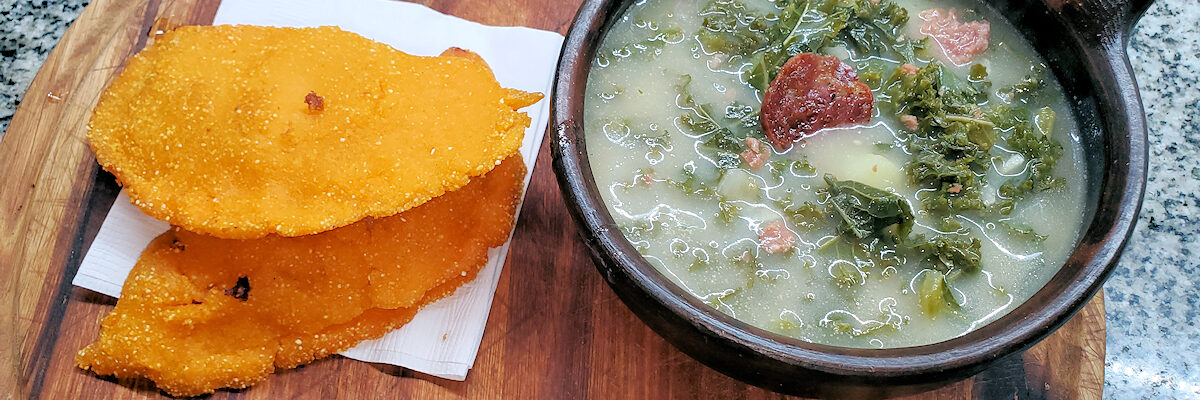
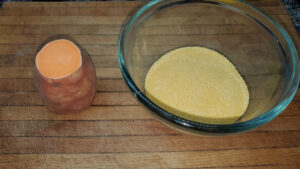
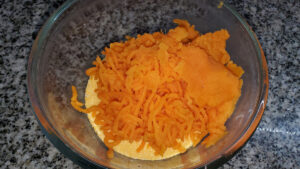
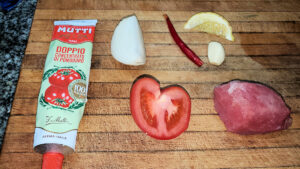
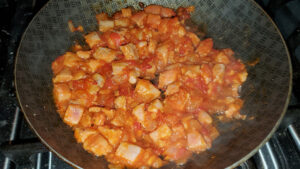
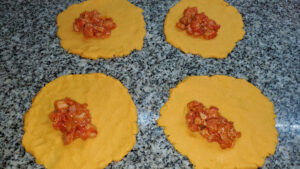
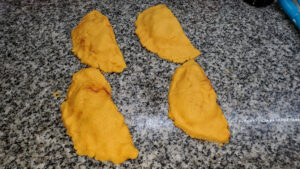
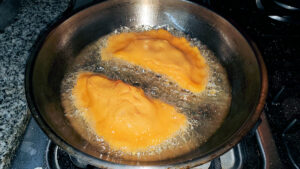
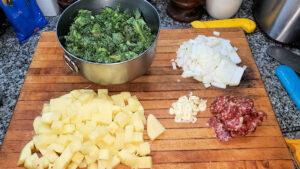
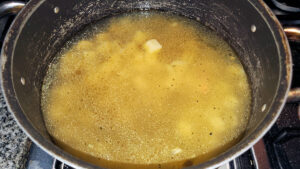
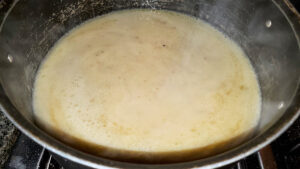
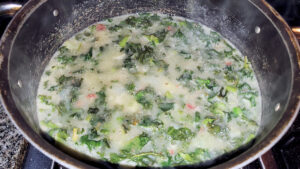
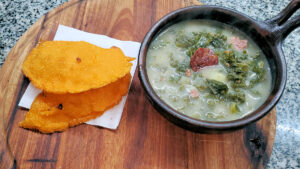
[…] up… staying in the general neighborhood of Africa, we’re off to Cape Verde (I already did Canada, out of alphabetical […]
[…] may remember a few entries back, on Cape Verde, when I was thinking I should have gone with an easier way to mold the pasteles, which are also […]
[…] “green broth”, this is only a slightly modified version of the one I made for the Cape Verde entry in The Bread & Soup Project. A base of onions, garlic sauteed in the oil from frying the […]